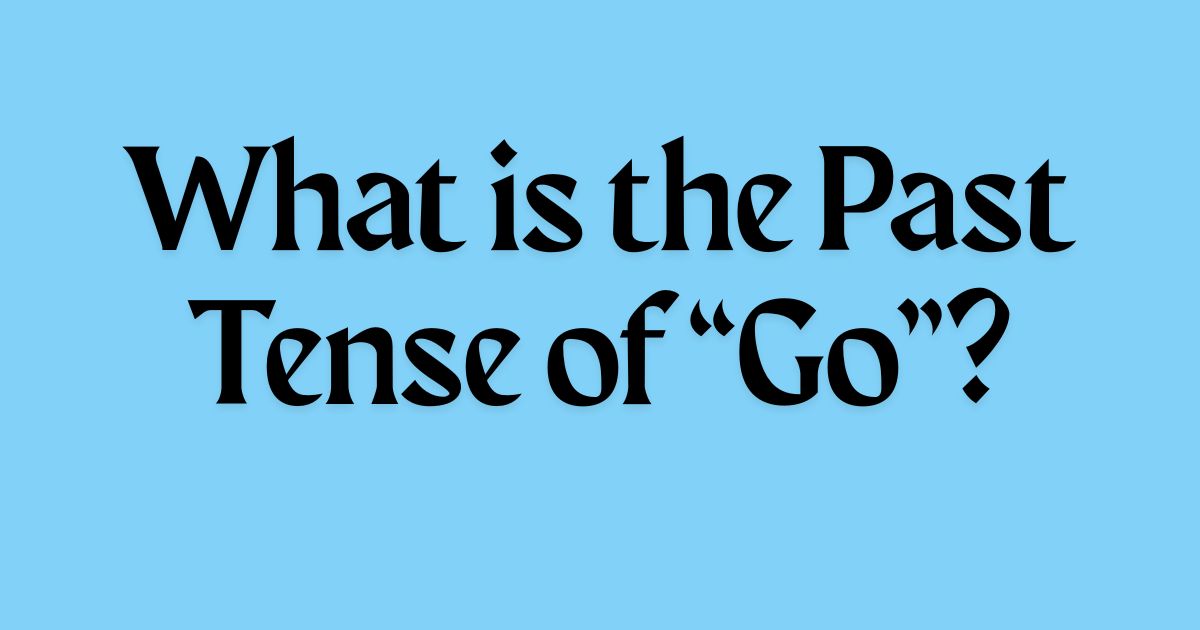“Go” is one of the most powerful verbs in English. We use go every day to talk about moving from one place to another. It’s simple but absolutely essential. Mastering go helps you speak clearly and confidently. You use go for things happening right now or in the future, like saying, “I go to school every day.”
But what if you want to talk about the past? That’s where things get interesting. You don’t say go anymore, you say went! That’s because go is an irregular verb, and its past tense changes completely. Learning when to use go and when to say went is the secret to speaking correct, natural English. This article will guide you through everything you need to know about go, its past tense, and how to use it like a pro.
Understanding the past tense is essential for mastering English grammar. It shows actions that happened before now, often using irregular verbs like went. Knowing how to switch from present tense to past tense improves your verb conjugation, sentence structure, and overall clarity in storytelling in English.
- Go (Present): The action of moving from one place to another. It’s a common action verb used in the present tense to describe something happening now or regularly.
- Went (Past): The past tense form of “go.” As an irregular verb, it doesn’t follow typical verb conjugation rules. We use it to describe past events or completed actions.
| Present Tense | Past Tense | Example Sentence |
| Go | Went | I go to the gym every morning. Yesterday, I went for a quick run instead. |
| Go | Went | They go hiking every weekend. Last Saturday, they went to a new trail. |
| Go | Went | She goes to school on weekdays. Last year, she went to a different school. |
When talking about something that already happened, the word went takes center stage. It’s the past tense of go and one of the most commonly used irregular verbs in English grammar. Unlike regular verbs, went doesn’t simply add “-ed”, it completely changes form. This shift is part of what makes learning verb conjugation in English education both fun and challenging.
Using went correctly is key in describing actions that happened at a specific time in the past. It adds clarity to your sentence structure and improves your narrative grammar, especially when practicing storytelling in English.
- She usually goes to the city on weekends, but last month, she went to the countryside for a quiet retreat.
Read More: What is the Past Tense of ‘Seek’? Is it ‘Seek’ or ‘Sought’?
In English grammar, understanding the shift from present tense to past tense helps you speak and write with clarity. Think of it like switching scenes in a movie, from what’s happening now to what happened before. The verb go is used to describe present actions, while went covers past events.
This simple yet essential tense comparison plays a key role in everyday conversation and language basics. Whether you’re writing a story or chatting casually, knowing when to use go vs went ensures smooth and accurate communication.
| Present Action | Past Event | Example Sentence |
| I go to work by bus. | Yesterday, I went by train. | Today, I go by car. |
| He goes to the gym daily. | Last week, he went on a hiking trip. | Now, he’s back to his routine. |
| We go shopping every Friday. | Last Friday, we went to a new mall. | This Friday, we go again. |
Picking between go and went depends on time expressions and the situation you’re talking about. For anything happening now or regularly, use go. If you’re reflecting on something that already occurred, choose went. It’s that simple, and essential in language learning.
This decision shows your grasp of verb forms and makes your storytelling more vibrant. Whether you’re learning grammar for beginners or polishing your skills, mastering this choice improves your flow and helps with natural-sounding speech.
| Present Scenario | Past Happening | Example Sentence |
| They go to school every day. | Last semester, they went online. | Now, they go in person. |
| You go to family dinners often. | Last holiday, you went to your cousin’s. | This year, you go to your parents’. |
| We go for walks at night. | Last winter, we went early in the evening. | Now, we go after sunset. |
Understanding how to use go correctly is a must for anyone learning English. The verb go helps you talk about moving from one place to another. You use go for present actions and future plans. But remember, when talking about past events, you must use went, the past tense of go. This change shows how go is an irregular verb. Getting this right will make your sentences clear and easy to understand.
Now you know the difference between go and went, you can use them with confidence. Using go in the right way is a big step in mastering English grammar. So keep practicing your verb conjugation and sentence structure. When telling stories or describing actions, choosing the correct form of go is key. Remember, learning the right past tense usage of go will help your English sound natural and smooth.

Grammarbeam is a smart language assistant built for clarity, creativity, and precision. From polishing grammar to exploring rich synonyms and refining sentence structure, Grammarbeam is your go-to tool for powerful communication. If you’re writing for school, business, or just for fun — let your words shine with Grammarbeam.

